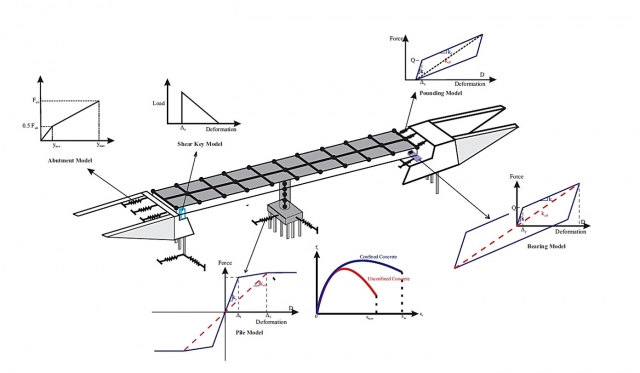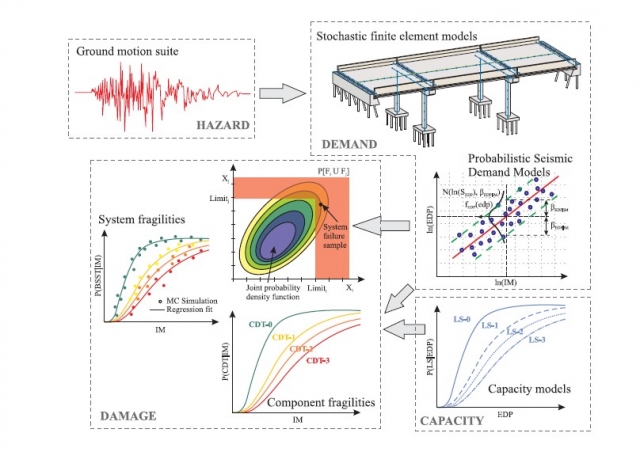Next Generation Bridge Fragility Functions for California Bridges


Co-PIs: Jamie Padgett, Rice University
Students: Sujith Mangalathu and Farahnaz Soleimani
Caltrans research project P266 is focused on developing a new generation of more accurate and more useful bridge fragility models for incorporation into Caltrans’ ShakeCast earthquake alerting system and to support seismic reliability evaluations of the state bridge inventory. Fragility models are statistical equations that describe the probability that a specific level of earthquake shaking will induce varying degrees of bridge damage ranging from minor spalling of concrete to complete bridge collapse. Successful development and deployment of improved fragility models into ShakeCast will facilitate a more effective post-earthquake emergency response where incident commanders, decision makers, and field inspectors have excellent situational awareness early in the response-operations timeline. Additionally, these same tools will improve planning capabilities by providing a uniform basis to assess the seismic reliability of California’s bridge inventory over a full range of hazard levels. Together, the improved fragility models within ShakeCast will provide for faster post-earthquake emergency response and restoration of network mobility, as well as support planning decisions regarding the allocation of capital resources for improved seismic safety and a more reliable transportation network.
Caltrans’ current deployment of ShakeCast uses HAZUS-based bridge fragility models developed in the 1990’s to support loss estimation by the Federal Emergency Management Agency. By necessity, these early models were derived with simplified analysis methods, compared to a limited set of damage observations, and use a bridge taxonomy based on the limited data fields available in the National Bridge Inventory (NBI). These models were framed in terms of broad damage state definitions (e.g. “extensive” damage) that do not adequately account for Caltrans post-earthquake inspection and repair strategies, and cannot be readily tied to bridge downtime and repair cost estimates. This early framework is not well aligned with Caltrans seismic design philosophy nor the California bridge inventory. The overall result is that bridge performance estimates have clearly not achieved their full potential for Caltrans application.
Project P266 is a multi-phase research initiative aimed at systematic development of “Generation-2 Fragility (g2F)” models tailored for the California bridge inventory that leverages Caltrans’ seismic design expertise, California earthquake hazard levels, advanced numerical modeling methods, and bridge information assets unique to Caltrans.
Publications- Mangalathu, S., Jeon, J-S., DesRoches, R., and Padgett, J.E. (2016). “ANCOVA-based grouping of bridge classes for seismic fragility assessment,” Engineering Structures, Vol. 123, pp. 379-394.
- Ramanathan, K., Jeon, J.-S., Zakeri, B., DesRoches, R., and Padgett, J.E. (2015). “Seismic Response Prediction and Modeling Considerations for Curved and Skewed Concrete Box-Girder Bridges,” Earthquakes and Structures, Vol. 9, No. 6, pp. 1153-1179.
- Ramanathan, K., Padgett, J.E., and DesRoches, R. (2015). “Temporal Evolution of Seismic Fragility Curves for Box Girder Bridges in California, Engineering Structures,” Vol. 97, pp. 29-46.
- Jeon, J.-S., Shafieezadeh, A., Lee, D.H., Choi, E., and DesRoches, R. (2015). “Damage Assessment of Older Highway Bridges Subjected to Three-Dimensional Ground Motions: Characterization of Shear-Axial Force Interaction on Seismic Fragilities,” Engineering Structures, Vol 87, pp. 47-57.
- Yang, C.S., Werner, S.D., DesRoches, R. (2015). “Seismic Fragility Analysis of Skewed Bridges in the Central and Southeastern United States,” Engineering Structures, Vol. 83, pp. 116-128.
- Eroz, M., and DesRoches, R. (2013). “A Comparative Assessment of Sliding and Elastomeric Seismic Isolation in a Typical Multi-Span Bridge,” Journal of Earthquake Engineering, Vol. 17, No. 5, pp. 637-657, November, 2013.
- Eroz, M., and DesRoches, R. (2013). “The Influence of Design Parameters on the Response of Bridges Seismically Isolated with the Friction Pendulum System (FPS),” Engineering Structures, Vol. 55, pp. 585-599, November, 2013.